Topic: The RCR
733146 Private William Tyler
A Canadian Soldier of the Great War
"Transferred to England for discharge as a MINOR."
Read the story of William Tyler's service on The Regimental Rogue.
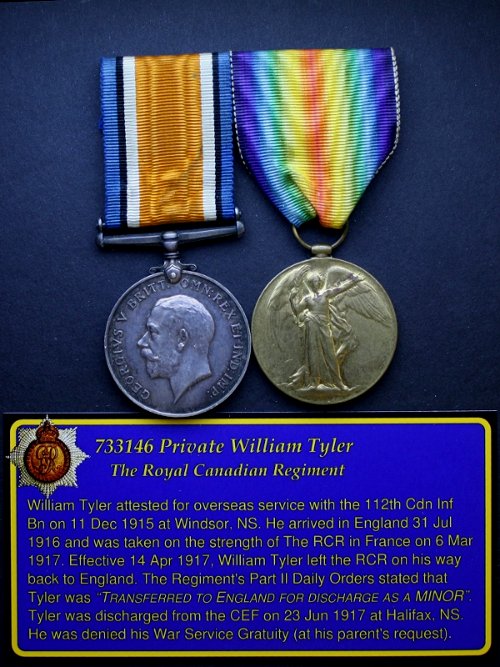
Read the story of William Tyler's service on The Regimental Rogue.


British Military Uniforms, James Laver, 1948
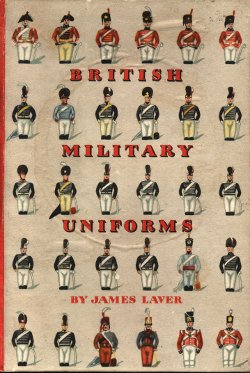 We have now followed, in a necessarily abbreviated and inadequate fashion, the history of British Military Uniforms from their beginning, with the rise of professional armies, to their virtual extinction under the conditions of modern, mechanized warfare. What conclusions, if any, can we come to at the end of our enquiry?
We have now followed, in a necessarily abbreviated and inadequate fashion, the history of British Military Uniforms from their beginning, with the rise of professional armies, to their virtual extinction under the conditions of modern, mechanized warfare. What conclusions, if any, can we come to at the end of our enquiry?
An attempt has been made elsewhere to establish the fundamental principles governing the evolution of all costume. These would seem to be -
The first attempts to make the wearer of clothes as attractive as possible to the opposite sex. It is, in general, the governing principle of female costume, but it is not without influence on men's, and particularly on soldiers' dress. It widens the military man's shoulders, narrows his hips, puffs out his chest, lengthens his leg and increases his apparent height. It plays, therefore, before the days of conscription, an important part in recruiting. Many a man who took the King's shilling did so in the firm conviction that there is nothing like a smart uniform to attract the girls; nor was he often mistaken. The heightening of masculine characteristics might also be considered of value, at least in early days, in intimidating the enemy, but such considerations have long been obsolete. The second principle establishes social position. It is the general principle governing male dress. In military costume it shrinks into a rigid ritualism of rank.
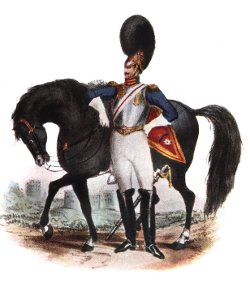 The utility principle has comparatively little influence on civilian costume. In modern male civilian dress it produces a succession of 'sports' clothes which gradually formalize themselves until they are too uncomfortable to be worn for any active pursuit and have to be replaced by something 'easier'. The same is true of military costume.
The utility principle has comparatively little influence on civilian costume. In modern male civilian dress it produces a succession of 'sports' clothes which gradually formalize themselves until they are too uncomfortable to be worn for any active pursuit and have to be replaced by something 'easier'. The same is true of military costume.
In considering military uniforms, therefore, we can (having made due note of the succession of stars and crowns and stripes on sleeve and shoulder) ignore the hierarchical principle. Military uniform is a tug of war between the seduction principle (in the sense of the heightening of masculinity, and 'martial' bearing) and the utility principle. Given a long peace, the seduction principle triumphs and soldiers become more and more gorgeous, but a war, especially a long war brings the utility principle once more into operation. The invention of long-range firearms and the raising of immense armies have enormously increased the weight of the utility principle until to-day we may say that the lone tug of war over, at least so far as fighting troops are concerned.
We may therefore attempt to tabulate the following conclusions:
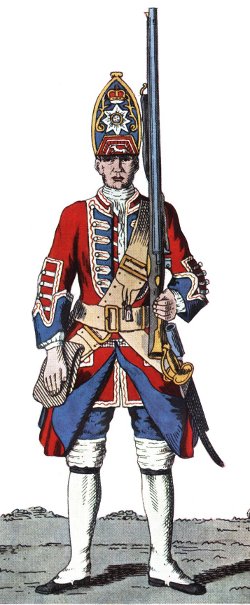 1. Military uniforms are the appurtenances of Kings' Bodyguards and the professional armies that developed from them. Their history is therefore very short – little more than than two hundred years.
1. Military uniforms are the appurtenances of Kings' Bodyguards and the professional armies that developed from them. Their history is therefore very short – little more than than two hundred years.
2. They are founded on contemporary civilian dress, somewhat modified in the direction of toughness by the utility principle, and nearly always modified in the direction of gorgeousness by the seduction principle.
3. Once established they seem to develop a life of the own, exaggerating all their characteristics to a degree fantasy not known in male civilian dress since the time of Charles II (that is, precisely, the period when uniforms began to develop).
4. Every war tends to drag uniforms back to the utility principle, expressing itself in looseness (for ease in battle) and in camouflage. Modifications, therefore, are likely to be first seen in the dress of Light Infantry and auxiliary troops generally, and in those engaged in colonial warfare.
5. Every army engaged in actual fighting is compelled, sooner or later, to develop its own battle dress. The uniform which it has discarded then becomes 'walking-out' dress, that is a 'smartened ' version of the battle dress' of the previous war.
6. Ceremonial uniform is often the battle dress (formalized and fantasticated) of the last war but one. In the days of huge conscript armies this is only retained by Household troops (that is by the King's Bodyguard).
7. The general colour of national uniforms (red for Britain, white for Austria, etc.) seems to be determined by accidents of history. That soldiers ever wore red because it did not show blood' (it does show it very clearly as a black stain) is a vulgar error. Once the utility principle has triumphed the colour of all uniforms is an attempt at camouflage.
8. Military fashions are extremely imitative. The dress of any successful troops will be copied, especially in unessentials, and any victorious nation tends to impose some detail of its uniform on the armies of the world.
9. Military headgear has two purposes: to protect the soldier's head and to increase his apparent height. The second purpose ruled almost exclusively, from the abandonment of the Cromwellian 'pot' to the First World War. The protection of the head (that is the utility principle) has now triumphed completely (the steel helmet once again) and the only consideration about the soldier's 'hat' is: how quickly and easily can it be stowed away?
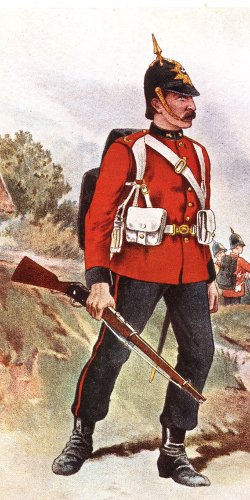 10. Cavalry uniforms follow certain peculiar lines of their own. They strive always for gorgeousness and display, and frequently develop decorations which make it impossible for their wearers to function as cavalry.
10. Cavalry uniforms follow certain peculiar lines of their own. They strive always for gorgeousness and display, and frequently develop decorations which make it impossible for their wearers to function as cavalry.
11. All cavalry tends to become 'Heavy' cavalry, and as 'Light' cavalry is always needed in war, recourse is had to the services of 'Auxiliaries'. These have, in the past, generally come from the less settled lands of Eastern Europe, and as their skill on horseback is admired their uniforms are copied, first slavishly and then with increasing fantastication (as, for example, in the astonishing history of the Hussar).
12. Mounted troops other than cavalry (for instance horse artillery) tend to adopt cavalry uniforms, with a marked preference for that of the Hussar.
13. Modern uniforms are vestigial in two senses of the term: they have become on the one hand a parade, or walking-out dress, and on the other have shrunk to mere insignia of rank or to miniature badges of territorial or regimental loyalty – a button and a pip. Before an actual assault even these are often discarded. In modern warfare, therefore, the utility principle has triumphed completely and the dress of commandos and tank crews is no more a 'uniform' in the proper sense of the term than are the dungarees of factory hands.
14. It is probable, however, that uniforms will continue to exist, paradoxically, as the costume of a soldier when he is not fighting.
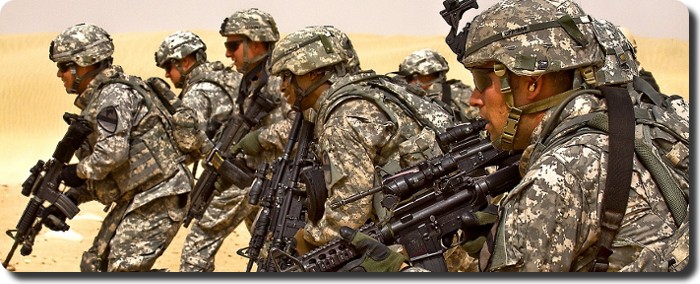
US Army Infantry Journal, July 1956
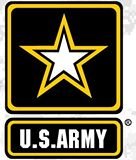 I am the Infantry—Queen of Battle! I meet the enemy face to face … close with him and destroy him. For two centuries, I have been the bulwark of our Nation's defense. I am the Infantry! Follow me!
I am the Infantry—Queen of Battle! I meet the enemy face to face … close with him and destroy him. For two centuries, I have been the bulwark of our Nation's defense. I am the Infantry! Follow me!
Hardship … and glory, I have known. My bleeding feet stained the snow at Valley Forge. With Washington, I crossed the Delaware … tasted victory at Yorktown … and saw our Nation born. I am the Infantry! Follow me!
At New Orleans, I fought beyond the hostile hour … discovered the fury of my long rifle … and came of age. I am the Infantry!
Westward, I moved with the covered wagon … marched with the empire across the plains … to far-flung outposts on the wild frontier. Follow me!
I went with Scott to Vera Cruz … battled Santa Anna in the mountain passes … and climbed the high plateau. I planted my flag in the Plaza of Mexico City. I am the Infantry!
From Bull Run to Appomattox my blood ran red. I served two masters … the Blue and the Grey … and united again under my banner of blue. I am the Infantry! Follow me!
I left these shores with the sinking of the Maine … led the charge up San Juan Hill … fought the Moro— and disease—in the Philippines. Across the Rio Grande, I chased the wily villain. Follow me! I am the Infantry!
At Chateau-Thierry, I went over the top. I stood like a rock on the Marne … cracked the Hindenburg line … broke the back of the Hun in the Argonne … and I didn't come back until it was "over, over here." I am the Infantry! Follow me!
At Bataan and Corregidor, I took a beating … licked my wounds and fought back. I invaded Tunisia on the African shore … dug my nails into the sand at Anzio … and marched into Rome with a flower in my helmet. I am the Infantry!
The channel and the hedgerow could not hold me. I broke out of the "Bulge" … jumped the Rhine … and took the Heartland. Follow me!
From island to island, I hopped the Pacific … hit the beaches … and chopped my way through swamp and jungle. I walked into the face of the Rising Sun. I am the Infantry! Follow me!
In Pusan perimeter I gathered my strength … crossed the frozen Han … marched to the Yalu. Along the 38th parallel … and around the world, I make my stand. I am the Infantry!
Wherever brave men fight … and die, for freedom, you will find me. I am the bulwark of our Nation's defense. I am always ready … now, and forever. I am the Infantry—Queen of Battle!
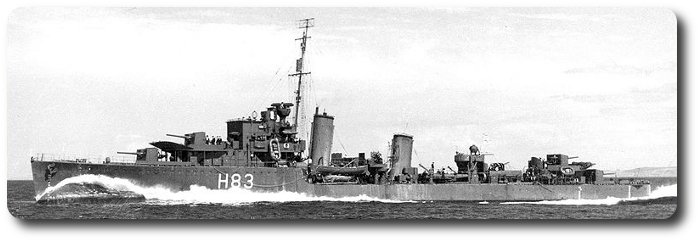
H.M.C.S. St Laurent; 20 August 1941
Ottawa Citizen, 19 January, 1937
Canada's national defence estimates brought down last night in the House of Commons have soared this year. The military, naval and air forces will need altogether $33,730,83. For these three services there is an increase over last year's main estimates of $14,363,434.
In the last fiscal year, however, the Defence Department continued to operate relief camps and controlled civil aviation. These two items cost $4,409,644 a year ago. Relief camps have been dropped, and civil aviation is now a branch of the Department of Transport, so that they do not now appear in the defence estimates.
The Royal Canadian Air Force will consume $11,391,650, which is considerably more than twice the sum expended last year when the total was $4,685,028.
The militia services appropriation is $17,850,428, an increase of $5,831,502, while the estimate for the naval service is $4,486,810, or $1,832,310 more than last year.
For civil government air operations, the Defence Department asks for $361,000, which is a drop of $153,987 from last year.
In a memorandum accompanying the tabling of the estimates it is shown that the personnel of the R.C.A.F. Is to be increased by 48 officers and 565 airmen, to a strength of 195 officers and 1,498 airmen, while an increase in the non-permanent sir force is contemplated, from 97 officers and 666 airmen to 118 officers and 946 airmen.
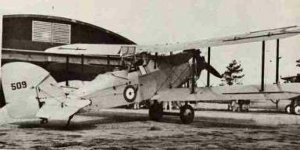
The Westland Wapiti was a redesign of the DeHavilland 9A (DH 9A). The first six Wapitis were accepted for RCAF service in July 1937. The second batch of 18 Wapitis was accepted for RCAF service in December 1938.
Provision is made for the acquisition of 102 airplanes. These will be distributed as follows:
Fighter, 12; army co-operation, 3; flying boats, 7; bomber, 24; torpedo bombing, 11; coastal reconnaissance , 18; training, 27.
This will bring the number of aircraft up to 284, of which many, however, are obsolete.
"Special efforts have been and will continue to be made," says the memorandum, "to have any new aircraft required by the Department of National Defence made in Canada; and the question of producing aero engines in Canada will continue to receive most careful attention."
The number of flying hours provided for in the estimates is double that of 1936-37. The organization of the non-permanent squadrons of the R.C.A.F. Will be advanced, and better training and equipment will be provided them.
"Of great importance," says the memorandum, "will be the construction of buildings and works in Nova Scotia, at Ottawa, Trenton, Vancouver, Vancouver Island, Prince Rupert, with minor additions or repairs at other points. Ground services are essential, and as much progress as possible will be made in this direction during the coming year.
"Some flying equipment, munitions, large stocks of tools, spare parts, as well as wireless telegraphy equipment, and mechanical transport will be obtained.
The Royal Canadian Navy will be increased by 373 men to 1,339 ranks and ratings. Other expenditures will embrace the increase in reserves of ammunition and torpedoes; harbor defence equipment, "particularly against submarines," at Halifax and Esquimalt; improved wireless equipment ashore; the constriction of four modern minesweepers, for which $750,000 is provided; naval share of joint service magazines at Esquimalt ($200,000).
"The department will continue to maintain four destroyers in commission," says the memorandum. "During the past year H.M.C.S. Champlain and Vancouver have been withdrawn and replaced by two efficient destroyers purchased from the government of the United Kingdom. These will be named H.M.C.S. Fraser and St Laurent.
Militia personnel provided for includes 465 officers and 3,760 other ranks in the permanent force. In the non-permanent active militia, provision is made to train 46,340 all ranks for periods of 10, 12, or 14 days according to the arm of the service.
Cadet services will be maintained on much same footing as in previous years.
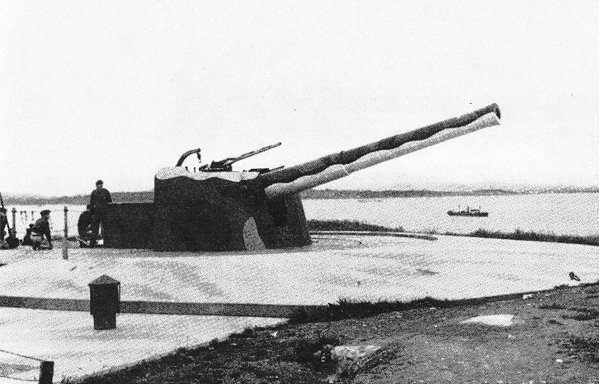
Coast Defence in Canada--British Columbia.— A 9.2-inch gun (with a 6-pounder sub-calibre gun mounted upon it for practice purposes) at Albert Head Battery, Esquimalt, B.C. This battery was constructed under the coast-defence programme undertaken in 1937. National Film Board image. Source)
The building program in addition to other projects, includes the following:
Petawawa Camp, Ont.—some small auxiliary buildings and facilities will be erected, and some work done on the roads in this camp area.
Barriefield, Ont.—further accommodation for married personnel, a garage and work-shop for technical vehicles will be built, as will be a central heating plant.
Valcartier, Que.—the filling group of Dominion arsenal at Valcartier will be completed, and three magazines with heating plants put up.
Quebec—the re-building of the fortification walls will be continued.
Pacific Coast defences—certain "necessary construction" will be commenced and carried out as quickly as possible as several points on the Pacific Coast. A new ordnance building will be put up at Esquimalt. An auxiliary magazine site will be obtained and some preliminary work carried out towards its development.
The estimates provided for acquisition of additional coastal defence batteries, and sites for their location," says the memorandum.
"In view of the recent reorganization of the militia, provision has been made for the purchase of certain specimen items of new equipment, for instruction and training in the new types of units."

R.H. Morrison; quoted in Vain Glory; A miscellany of the Great War 1914-1918, Guy Chapman, OBE, MC (Ed), 1937/1968
He was taught the three arts of war, so much more necessary than musketry, field engineering or tactics. Or were they, perhaps, part of tactics?
Wangling, Scrounging, and Winning. …
Wangling was the art of obtaining one's just due by unfair means. For instance, every officer and man of the B.E.F. had his allotted daily rations, his camp or billet, his turn for leave. In practice, to get these necessities, it was well to know the man who provided them and do him some small service—a bottle of whiskey, the loan of transport (if you had any) or of a fatigue party. Wangling extended to the lowest ranks. Men wangled from the N.C.O.s the better sorts of jam and extra turns off duty. …
Scrounging could be defined as obtaining that which one had not a shadow of a claim by unfair means. It was more insidious that as the Wangle, but just as necessary—men scrounged the best dug-outs off one another, or off neighbouring sections. N.C.O.s scrounged rum by keeping a thumb in the dipper while doling it out, Officers scrounged the best horse lines from other units. Colonials scrounged telephone wire to snare rabbits …
The Art of Winning. It may be defined as Stealing. More fully, it was the Art of obtaining that which one had no right to, for the sake of obtaining it, for the joy of possession. … Some say it was simply the primeval joy of loot, …
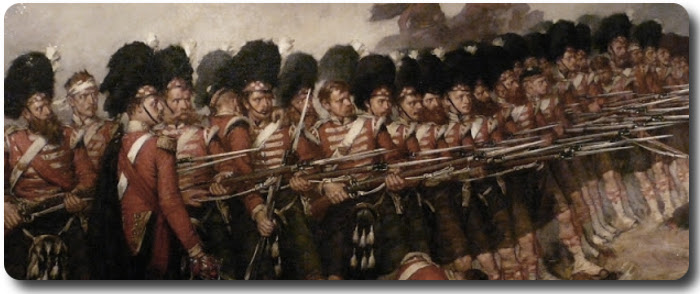
Voice from the Ranks; A Personal Narrative of the Crimean Campaign by a Sergeant of the Royal Fusiliers, Sergeant-Major Timothy Gowing, edited by Kenneth Fenwick, 1954
One day in March I was one of the sergeants with a party of men that had been sent to Balaclava to bring up supplies in the way of biscuit and pork, or salt junk (salt beef). We had a young officer with us, well mounted, who had but little compassion for poor fellows who were doing their best, trudging through the mud up to their ankles, with a heavy load upon their backs. The party were not going fast enough to suit the whim of our young and inexperienced commander, who called out to the writer.
The unfortunate man was doing his best to keep up, and he gave our young officer such a contemptuous look as I shall not forget as long as I live. Throwing his load of biscuit down in the mud, he exclaimed: 'Man indade! Soger indade! I'm only a poor broken-down commissariat mule!'
Here a light-hearted fellow burst out with 'There's a good time coming, boys !'
The poor fellow was made a prisoner of at once, for insubordination. But when I explained the case to our Colonel he took quite a different view of the matter, forgave the man, and presented him with a pair of good warm socks and a pair of new boots; for the poor fellow had nothing but uppers and no soles for his old ones. And in order to teach our smart young officer how to respect men who were trying to do their duty sentenced him to three extra fatigues to Balaclava—and to walk it, the same as any other man.
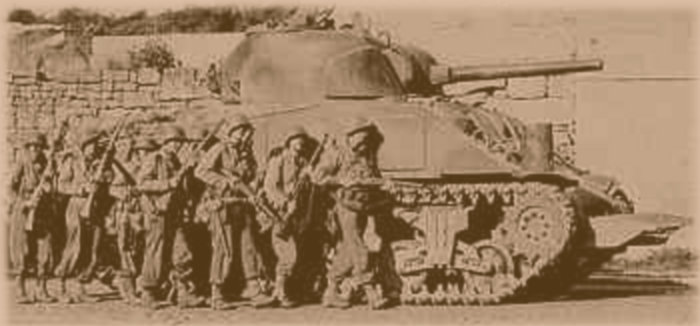
The Lonely Leader; Monty, 1944-1945, Alistaire Horne, 1994
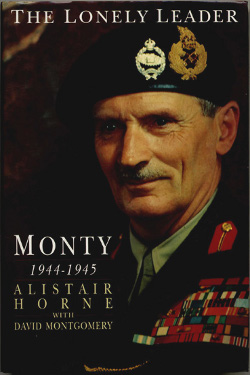 It is a truism that, in a peace-orientated democracy, the panoply of war generally reflects the civilian industrial base rather than that which it requires ideally to win a war. But, as Correlli Barnett acidly notes, the pre-war British motor-vehicle industry 'had concentrated on small family cars and light vans, suitable for a sedate Sunday outing to the seaside and deliveries of groceries...'. Detroit was perhaps equally open to blame. The thirty-ton M-4 Sherman, whose surprise advent on the battlefield had helped turn the tide in the desert in 1942, had all the merits and defects of the US automobile industry such as Ralph Nader in the 1960s had savaged as 'Unsafe At Any Speed'. It could be mass-produced in vast numbers; it was fast (30 m.p.h.) and spaciously comfortable (until it 'brewed up') for crews, compared with the British Cromwells; but it had an uncomfortably high profile in battle. It had inadequate armour, easily caught fire and mounted a 75mm gun descended with little modification from the famous piece that had been the mainstay of the French Army in 1914 - though too light even then. Excellent in 1942, by 1944 it was totally outclassed, capable of penetrating only 68mm of armour, the German Panther, star of Normandy, boasted 100 mm of well-sloped frontal armour, while its long 75mm KwK 42 could penetrate 118mm of armour at 1000 yards - and the Sherman had only 68mm of frontal protection. The main fault of the Panther, and even more of the heavier (58 ton) Tiger, lay in the slow traverse of its turrets, so the best chance the Allied Shermans and Cromwells had in Normandy was when three or four could each take on one of the superior German Panzers - much as the three little British cruisers - Ajax, Achilles and Exeter - had worried to death the mighty Graf Spee in the Battle of the River Plate.
It is a truism that, in a peace-orientated democracy, the panoply of war generally reflects the civilian industrial base rather than that which it requires ideally to win a war. But, as Correlli Barnett acidly notes, the pre-war British motor-vehicle industry 'had concentrated on small family cars and light vans, suitable for a sedate Sunday outing to the seaside and deliveries of groceries...'. Detroit was perhaps equally open to blame. The thirty-ton M-4 Sherman, whose surprise advent on the battlefield had helped turn the tide in the desert in 1942, had all the merits and defects of the US automobile industry such as Ralph Nader in the 1960s had savaged as 'Unsafe At Any Speed'. It could be mass-produced in vast numbers; it was fast (30 m.p.h.) and spaciously comfortable (until it 'brewed up') for crews, compared with the British Cromwells; but it had an uncomfortably high profile in battle. It had inadequate armour, easily caught fire and mounted a 75mm gun descended with little modification from the famous piece that had been the mainstay of the French Army in 1914 - though too light even then. Excellent in 1942, by 1944 it was totally outclassed, capable of penetrating only 68mm of armour, the German Panther, star of Normandy, boasted 100 mm of well-sloped frontal armour, while its long 75mm KwK 42 could penetrate 118mm of armour at 1000 yards - and the Sherman had only 68mm of frontal protection. The main fault of the Panther, and even more of the heavier (58 ton) Tiger, lay in the slow traverse of its turrets, so the best chance the Allied Shermans and Cromwells had in Normandy was when three or four could each take on one of the superior German Panzers - much as the three little British cruisers - Ajax, Achilles and Exeter - had worried to death the mighty Graf Spee in the Battle of the River Plate.
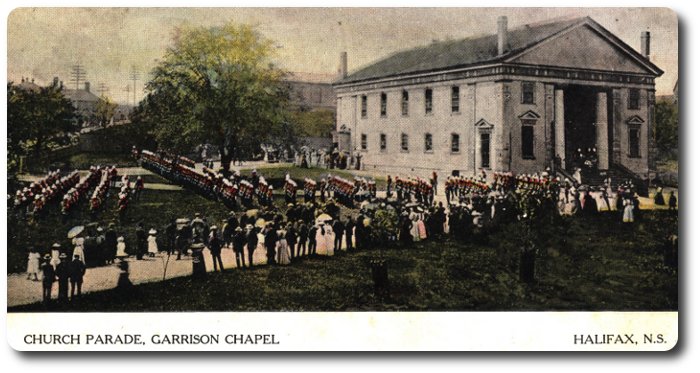
The Royal Canadian Regiment, 1883-1933, R.C. Fetherstonaugh, 1936
As the Headquarters' file of Regimental Orders for 1913 and most of 1914 was destroyed in the Halifax explosion in 1917, and as a prolonged search has failed to discover copies in Ottawa, or at any of the Regimental Depots, the exact sequence of events in this period is now difficult to ascertain, but, thanks to private diaries and similar memoranda, a record of some incidents has been preserved. There was, for example, the March of the Lone Baptist, an event unparalleled in the Regiment's, or perhaps any other regiment's, history.
From the time when the unit assumed garrison duties in Halifax in 1905, it had been the custom of the band to march in the church parades of the Church of England, Presbyterian and Roman Catholic detachments in rotation, leaving the smaller denominations to proceed without musical accompaniment. On the complaint of certain Ministers in Halifax against what they considered unfair discrimination, the Honourable the Minister of Militia and Defence ruled that all denominations must be treated alike and that the band must accompany each detachment in turn. In accordance with these orders, Sunday, April 27 [1913], was allotted to the Baptist denomination. There were three Baptists serving in the Regiment in Halifax at the time, two of whom were on detached duty, but the orders were explicit. Accordingly, the lone Baptist was paraded, Lieut. H.T. Cock assumed command of the parade, the Regimental Sergeant-Major took his appointed post, two police joined the detachment as usual, the band of approximately 40 pieces struck up an appropriate air, and off the Baptist was marched to his place of worship more than a mile away. Flattering as the escort must have been, the service would have seemed to have displeased him. No exact explanation is now available, but it is on record that he paraded before the Commanding Officer and changed his religion on the following day, an example which the adherents of other minor denominations were prompt to follow.

The Royal Canadian Regiment, 1883-1933, R.C. Fetherstonaugh, 1936
As the Headquarters' file of Regimental Orders for 1913 and most of 1914 was destroyed in the Halifax explosion in 1917, and as a prolonged search has failed to discover copies in Ottawa, or at any of the Regimental Depots, the exact sequence of events in this period is now difficult to ascertain, but, thanks to private diaries and similar memoranda, a record of some incidents has been preserved. There was, for example, the March of the Lone Baptist, an event unparalleled in the Regiment's, or perhaps any other regiment's, history.
From the time when the unit assumed garrison duties in Halifax in 1905, it had been the custom of the band to march in the church parades of the Church of England, Presbyterian and Roman Catholic detachments in rotation, leaving the smaller denominations to proceed without musical accompaniment. On the complaint of certain Ministers in Halifax against what they considered unfair discrimination, the Honourable the Minister of Militia and Defence ruled that all denominations must be treated alike and that the band must accompany each detachment in turn. In accordance with these orders, Sunday, April 27 [1913], was allotted to the Baptist denomination. There were three Baptists serving in the Regiment in Halifax at the time, two of whom were on detached duty, but the orders were explicit. Accordingly, the lone Baptist was paraded, Lieut. H.T. Cock assumed command of the parade, the Regimental Sergeant-Major took his appointed post, two police joined the detachment as usual, the band of approximately 40 pieces struck up an appropriate air, and off the Baptist was marched to his place of worship more than a mile away. Flattering as the escort must have been, the service would have seemed to have displeased him. No exact explanation is now available, but it is on record that he paraded before the Commanding Officer and changed his religion on the following day, an example which the adherents of other minor denominations were prompt to follow.
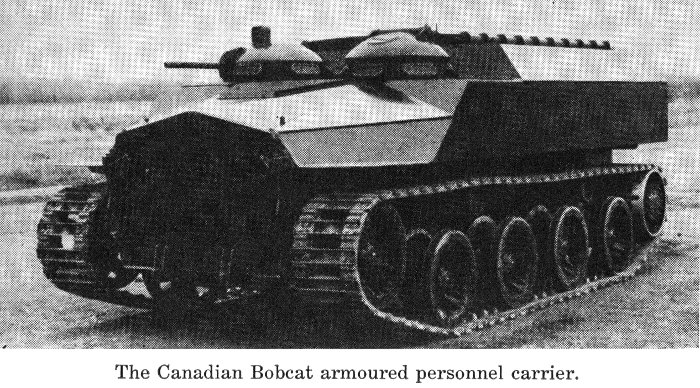
Ottawa Citizen, 11 July 1963
By Charles Lynch, Southam News Service
The austerity-pinched Canadian army needs additional manpower it is it to fulfill its commitments in Europe and for home defence, Lt. Gen. Geoffrey Walsh, Chief of the General Staff, told the Commons defence committee today.
He gave the committee a picture of general army readiness, but pointed out several thin spots and dramatized the deficiencies by saying Canadian troops in Europe are "directly in the middle of the path" of any Soviet ground offensive.
He also described the peril of Soviet airborne troops establishing beachheads on Canadian soil, and the necessity of maintaining home defence forces to counter any such invasion.
General Walsh said the principle had now been established that two of the three army brigades now in Canada would be transported to Europe to "marry up" with the NATO army brigade.
But such a move, he said, would impose heavy drains on available manpower—and "to replace this manpower the only thing we can do is to avail ourselves of ex-Regulars and selected Militia personnel."
At no point did he mention the explosive topic of conscription, but he made it clear that when army force goals were cut from 59,000 to 50,000 in an austerity program last autumn, it left the army in a hard pressed condition to meet its commitments.
General Walsh outlines the army's equipment needs in addition to its manpower requirements, placing the emphasis on the Bobcat armoured personnel carrier as the item urgently needed.
Twenty prototype Bobcats are currently being produced for evaluation, following which a production order of 500 vehicles is expected.
General Walsh said the decision to deploy two additional brigades in NATO — even though they may not be moved into position immediately — involved detailed planning with the British War Office, since Canada's NATO troops are on the British supply system.
One of the brigade groups now in Canada could be move in a reasonably short time, he said and the second brigade group could be made available soon afterwards.
The question of stockpiling equipment for two reserve brigades in Europe had been looked at, he said, "but a preliminary study places the cost at approximately $135-million and a manpower requirements of at least 400 officers and men."
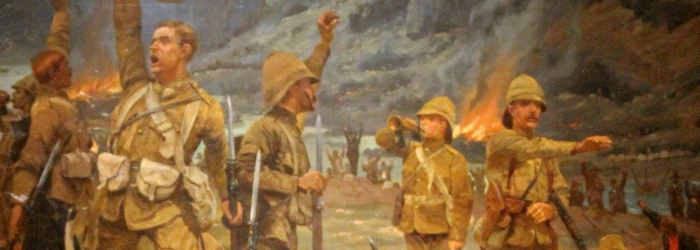
St John Daily Sun; 25 April, 1901
"Canada has taken her place among the nations of the world, and she must be prepared to assume at least part of the responsibilities of a nation. In every civilized country the prowess of the Canadian soldier is recognized. He is a man, the conditions of whose life enables him to successfully compete with the best soldier of the world."
Ottawa, April 22.---Militia matters were discussed in the House of Commons on Friday before and after going into supply. The speeches of Col. Thompson of Haldimand and Monk; Hon. Col. Prior of Victoria; Mr. Fowler of Kings, N.B., and Mr. Kaulbach of Lunenburg, N.S., show that an entirely new feeling has been produced by the South African was in regard to our volunteer force. The day had gone by when members of the Canadian militia will be referred to as feather-bed soldiers. Fighting side by side with crack British regiments, they were not only able to hold their own, but often went one better and taught the regular "Tommy" that "Johnnie Canuck" was equal to any emergency in the firing line. Col. Hutton stated that it would be useless to send Canadian militia battalions to the front, unless they were associated with regular line regiments. How his judgment erred in the particular was demonstrated repeatedly and during the course of the campaign and with Canadians recommended for the Victoria Cross, and other distinguished honours, the rewards of the bravest of the brave, it is no wonder that we feel proud of the men who so nobly upheld the honour of their flag and their country. During the course of the debate, Major Gen. O'Grady Haly occupied a seat in the speaker's gallery, and he heartily applauded the sentiments expressed in regard to the courage of our men.

Having found in the Canadian soldier traits which have been attributed only to British troops of the regular force, it is not to be wondered that parliament feels something must be done to make available the splendid force which can be mustered in this country. Therefore, they are inclined to look upon the militia force from a common sense standpoint and to be governed by the lessons gathered from recent movements in South Africa. It was urged that there was altogether too much lace and feathers about the style of dress now provided for in militia regulations. Dress does not make a soldier, and it often prevents capable men from offering their services as officers. The Boer was found to be a man who could shoot straight, and to whom dress was a matter of little concern. Officers could not be distinguished from men, and the result was that the English troops had to fall in line and a superior officer had to place himself on a level with the private in so far as dress was concerned. The Australians already have a uniform for their volunteers which necessitates a very small outlay for an officer to place himself in a position to qualify for a commission. It was pointed out that in military schools, even for a six months' course, it is almost necessary that a man should be provided with regular mess and dress uniforms, involving an expenditure of hundreds of dollars, which many young men who would doubtless make excellent officers, are not prepared to make. The opinion expressed by members of parliament, representing all parts of Canada, was favorable to a scheme which would abolish the system of dress now in vogue and make it as domestic as possible. Although the rules of the military schools do not require a man to provide himself with mess and dress uniforms, hardly any man could be induced to enter the military course, where nearly everybody was fully supplied with all necessary clothing, without feeling that he was more or less humiliated without them. And so it has been suggested that the militia should be made a poor man's organization, as well as a rich man's paradise, and that every encouragement should be given to those in the humbler stations of life who desire to seek commissions.

Shooting is looked upon as the most essential feature of a soldier's drill in these modern days. It was urged upon the minister of militia that too much attention could not be given to this department of militia drill. In Switzerland every soldier is a crack shot, and the result is that that little republic could defend herself against almost any of the great powers of Europe. The authorities there recognize the fact that to shoot straight means that a small army only is necessary to protect the country. And so it is proposed to make Canada a land of sharpshooters. Then, in the event of an invasion from the United States or other countries, our forces would be able not only to make a good showing against any foreign army, but could more than hold their own against very superior forces. Col. Thompson desires to see the company and battalion drill largely replaced by rifle practice during the time men are in camp. Under existing circumstances forty rounds of ammunition are served out, and the men are allowed to blaze away at the targets until the supply is exhausted. This is neither conducive to good shooting nor profitable to the country which supplies the cartridges. What is needed is more ammunition and more time to fire it in, and then a marked improvement in shooting may be expected in the militia ranks.

A suggestion has also been made that more money should be voted for the construction of rifle ranges in country sections. In the cities large armouries are erected, while the rural districts get little or nothing in the way of public works to encourage militia bodies. With fewer armouries in the towns and more rifle ranges in the country, a number of members of parliament think that the question of marksmanship will be solved. An opportunity will also be afforded for the formation of rifle clubs, and in this way the defensive forces of the country will be greatly strengthened. When it is remembered that only 36,000 militia are organized throughout Canada, the demand for recruits in time of danger will be fully appreciated. Thousands of business men who have never carried a rifle would have to bear arms, and it is proposed that the militia forces should be extended so as to take in all classes. The rifle clubs will have the effect of meeting this demand to a certain extent, but the only practical way to utilize the material at hand is to provide facilities for general rifle practice.

Considerable attention was devoted to the condition of the rural corps. Col. Thompson claims that men enlisting for three years should be paid in proportion to the time actually served in camp. His proposition is that the first year a soldier goes to camp he shall receive fifty cents a day, in the second camp he shall receive 65 cents a day, and for the third and subsequent camps he shall received 75 cents a day. He contends that if this graded system were authorized, complaints of the lack of interest in non-attendance on the part of the men after the first year would entirely disappear. Rural camps should also be supplied with many comforts which are now lacking. For instance, it was suggested that a mess tent should be provided, so that the men might have a place to partake of their meals in comfort. Although a soldier on active service has frequently to sleep in the open and submit to many inconveniences, that is no reason why he should do it in times of peace. If more attention be paid to little comforts of this kind, many men who now stay at home after their first experience in camp, would gladly return and participate in the drill year after year.

In connection with the absence from the camp of men who have served their first year, it was shown that as a rule rural camps are largely made up of recruits of tender years. It has been demonstrated on the battlefield and in the marches of South Africa, that well matured and developed soldiers are best suited for campaigning purposes. In order to get these men to participate in the annual drills ir is almost necessary that provision should be made to increase their pay. They often have families to support, and are therefore unable to neglect their work for the miserable pittance now allowed by the militia department.

Another scheme which promises to increase the efficiency of the Canadian militia forces, is that suggested by the minister of militia in reference to mounted infantry. These forces will be raised largely in the rural districts. It is proposed to have at least one company of mounted infantry attached to each line regiment. When in camp, the different companies can be brigaded for special drill and in this was an efficient force will be assured. In the west it is proposed to make provision for two composite regiments of mounted infantry and they will be drilled on lines which were found serviceable in the South African war.

Exception was taken to the present system of storing rifles in central armouries. The twentieth century rifle is a weapon that is liable to become obsolete at any time. It may be fitted for use in an army today, and tomorrow be good for little more than scrap iron. Under these circumstances it is urged that the troops in the country districts should be allowed to use their rifles on every possible occasion, so that they might become familiar with their use. By storing them in central armouries, the militia department renders the practical use of rifle impossible.

It would seem, therefore, as if the day for a complete reform of the Canadian militia forces has arrived. Canada has taken her place among the nations of the world, and she must be prepared to assume at least part of the responsibilities of a nation. In every civilized country the prowess of the Canadian soldier is recognized. He is a man, the conditions of whose life enables him to successfully compete with the best soldier of the world. Brought up in a vast open country, he has inherent qualifications which peculiarly fit him for a place in the ranks of the great British Empire. Canad is fast learning to appreciate her responsibilities. With so many reforms suggested and concurred in by the minister of militia, we may not be considered optimistic, if we look upon the Canada of the future as a country whose troops will command the respect and fear of every civilized power in the world.
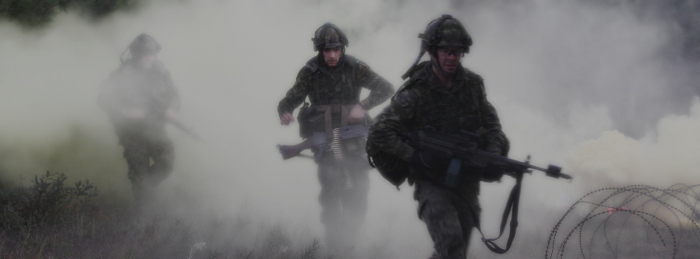
Men Against Fire, S.L.A. Marshall, 1947
The characteristics which are required in the minor commander if he is to prove capable of preparing men for and leading them through the shock of combat with high credit may therefore be briefly described:
(1) Diligence in the care of men.
(2) Administration of all organizational affairs such as punishments and promotions according to a standard of resolute justice.
(3) Military bearing.
(4) A basic understanding of the simple fact that soldiers wish to think of themselves as soldiers and that all military information is nourishing to their spirits and their lives.
(5) Courage, creative intelligence, and physical fitness.
(6) Innate respect for the dignity of the position and the work of other men.

The Military Institutions of the Romans, Flavius Vegetius Renatus, translated from the Latin by Lieutenant John Clark, Military Service Publishing Co. Edition, 1944
It is the nature of war that what is beneficial to you is detrimental to the enemy and what is of service to him hurts you. It is therefore a maxim never to do, or to omit doing anything as a consequence of his actions but to consult invariably your own interest only. And you depart from this interest whenever you imitate such measures as he pursues for his benefit. For the same reason it would he wrong for him to follow such steps as you take for your advantage .
The more your troops have been accustomed to camp duties on frontier stations and the more carefully they have been disciplined the less danger they will be exposed to in the field.
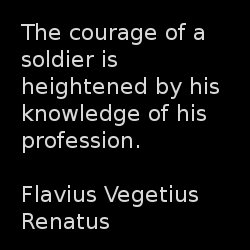 Men must be sufficiently tried before they are led against the enemy.
Men must be sufficiently tried before they are led against the enemy.
It is much better to overcome the enemy by imposing upon him famine, surprise or terror than by general actions for in the latter instance fortune has often a greater share than valor.
Those designs are best of which the enemy are entirely ignorant till the moment of execution. Opportunity in war is often more to be depended on than courage.
To seduce the enemy's soldiers from their allegiance and encourage them to surrender is of especial service, for an adversary is more hurt by desertion than by slaughter.
It is better to have several bodies of reserves than to extend your front too much.
A general is not easily overcome who can form a true judgment of his own and the enemy's forces.
Valor is superior to numbers.
The nature of the ground is often of more consequence than courage.
Few men are born brave; many become so through training and force of discipline.
An army is strengthened by labor and enervated by idleness.
Troops are not to be led to battle unless confident of success.
Novelty and surprise throw an enemy into consternation, but common incidents have no effect.
He who rashly pursues a flying enemy with troops in disorder, seems bent upon throwing away that victory which he had before obtained.
An army unsupplied with grain and other necessary provisions risks being vanquished without striking a blow.
A general who trusts to his cavalry should choose the proper ground for them and employ them principally in the action.
He who depends on his infantry should choose a situation most proper for them and make full use of them.
When an enemy's spy lurks in the camp, order all your soldiers in the day time to their tents, and he will instantly be apprehended.
On finding that the enemy has notice of your designs, you must immediately alter your plan of operations.
Consult with many on proper measures to be taken, but communicate the plans you intend to put in execution to few, and those only of the most assured fidelity. Or better trust no one but yourself.
Punishment, and fear thereof, are necessary to keep soldiers in order in quarters; but in the field they are more influenced by hope and rewards.
Good officers never engage in general actions unless induced by opportunity or obliged by necessity.
To distress the enemy more by famine than the sword is a mark of consummate skill.
Many instructions might be given with regard to the cavalry. But as this branch of the service has been brought to perfection since the ancient writers and considerable improvements have been made in their drills and maneuvers, their arms, and the quality and management of their horses, nothing can be collected from those writers' works. Our present mode of discipline is sufficient.
Dispositions for action must be carefully concealed from the enemy, lest they should counteract them and defeat your plans by proper expedients. Lest the soldiers in the confusion of battle should be separated from their comrades, every cohort had its shields painted in a manner peculiar to itself. The name of each soldier was also written on the shield, together with the number of the cohort and century to which he belonged.
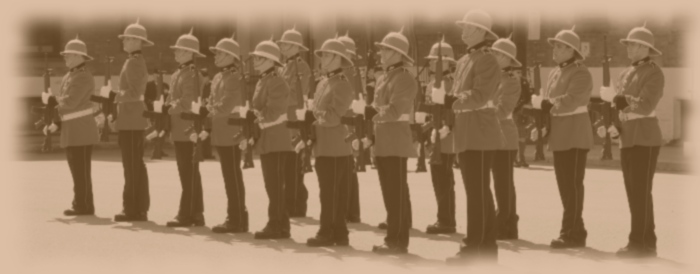
An Open Letter to the Very Young Officer, by C.N.W. (From the Journal of the Royal United Services Institution, Vol. LXII., February to November, 1917)
In the Old Army the great majority of the officers were drawn from the class, or genus, which in the bird world is represented by the gallinaceous, or combative, fowls, you who read this may belong to that' genus, or you may come of a more peaceful and dove-like stock, but if from the latter you show an amazing pugnacity which, dropping the bird metaphor, goes to prove that the Germans and our own ante bellum croakers were a bit out in their prognostications that the British race was decadent, and that the British lower middle class was so steeped in commercialism and the labouring classes in Trade Unionism—relieved by striking and watching professional football matches—as to be of no account as fighting men.
Events have proved that the race can fight as well as ever it did—all classes and sections of it, "Duke's son, cook's son, or son of a belted earl"; but don't run away with the idea that because you possess the national courage, and your name has appeared in the London Gazette as a Temporary Second Lieutenant, you are by mere virtue of being a commissioned officer also a leader of men, to be that you must possess, or set to work to acquire if you want to be a good officer and not a useless—and therefore in war a dangerous—slacker, the qualities which make for leadership.
I don't suppose you have had time, recently, to indulge in light literature such as Blackwood's Magazine, or the Journal of the Royal Artillery Institution, in which case you will have missed reading in the former the description—under the title "Fallen Angels"—of the gradual, and at times painful, process of forming the young, New Army, officer in a cadet corps, and, in the latter, the very excellent open letter by "Esterel" to the Junior (Artillery) Subaltern.
This is what the author of "Fallen Angels" has to say-and it is worth considering-about the qualities which make for leadership:—
"The obvious qualities that an officer must possess … are …
"(1) The gift of leadership.
"(2) A personality and a character that will command the respect of the men committed to his care.
"(3) A smart personal appearance combined with cleanly and temperate habits, for no man can be expected to respect a leader who never washes, or is seen to be tight, or wandering about in a public place arm in arm with ladies of slight reputation."
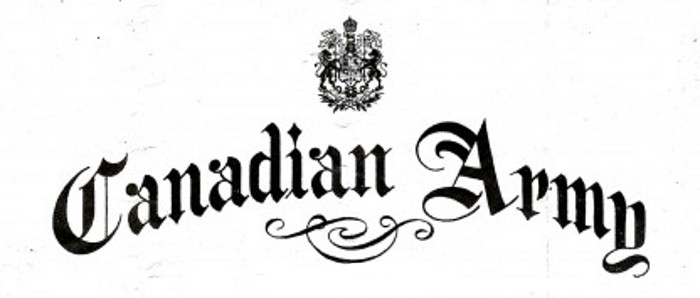
The Montreal Gazette, 1 January 1947
Ottawa, December 31.—CP—The Canadian Army in 1946 discharged 250,000 and repatriated more than 100,000 of the men and women who brought it wartime lustre and, simultaneously, began erecting the basic framework for a potential peacetime force of 25,000 regular and 180,000 reserve soldiers.
A year-end review issued by Army headquarters was dominated largely by the bonded tasks of repatriation and demobilization but it was dotted, too, with the establishment of the new system of five regional commands, with the opening training and research skirmishes against the wilderness of the north with the formation of a brigade group as the nucleus of any new fighting army, with the announcement of educational qualifications designed to put the new force on a high mental plane.
Last January [1946] , there were 110,000 Canadian servicemen and women still overseas. All but approximately 1,000 have now been returned.
Repatriation officials also had to find transportation for half that many wives and children of Canadian servicemen.
Discharges skyrocketed, and more than 250,000 men and women left the army. Most of these veterans now are reestablished on civvy street.
Although an advance party arrived at Fort Churchill, Man., late in 1945, that far northern port was not opened until shortly after the new year when several hundred men of Exercise Muskox—first major peace-time army manoeuvre—moved in. Muskox, a 3,000-mile, 81-trek of a handful of scientists and soldiers through the little known eastern Arctic and lush Mackenzie River basin, undoubtedly produced much of the scientific knowledge of benefit to soldier and civilian alike. Since late summer, Churchill, on Hudson's Bay, has been a permanent joint service experimental station.
The army further expanded itself northward on taking over the Alaska Highway from its builders and former custodians, the Americans. Brig. Geoffrey Walsh, C.B.E., D.S.O., was appointed officer commanding and chief engineer in April and the highway was renamed the North West Highway System. By the end of the year the number of men, including maintenance crews and technicians employed with the system, had reached approximately 700.
The year saw the disbandment of the Canadian Woman's Army Corps. In all, more than 21,000 women and girls served with the corps at home and in both the Mediterranean and European theatres.
In July, the army completed withdrawal of all men stationed in Newfoundland. It was first garrisoned by Canadian troops in June, 1940. Peak strength of the Canadian force there barely exceeded 6,000.
The long-awaited formation of the brigade group of the new army was announced late in August. Its strength was given as about 7,000, and field units listed as components included the 71st Regiment, Royal Canadian Horse Artillery; the 1st Armored Regiment, Royal Canadian Dragoons; and the 2nd Armored Regiment, Lord Strathcona's Horse. The brigade also contained components of the Royal Canadian Engineers, Signals, Army Service Corps, Ordnance, and Electrical and Mechanical Engineers. In addition, three former permanent force regiments, The Royal Canadian Regiment, Princess Patricia's Canadian Light Infantry, and the Royal 22nd Regiment, were listed as comprising the infantry component of the brigade group.
Among many high-ranking officers retired during 1946 was Gen. H.D.G. Crerar, commander of the First Canadian Army in Europe.
Biggest ceremonial anxiety undergone by the Army was the visit of Field Marshal the Viscount Montgomery of Alamein. It induced extra work but was singularly fee from the volume of official red tape usually connected with similar affairs.
One of the last statements issued by former Defence Minister Abbott dealt with the formation of an interim defence research board, created to make available the experience of its members to assist the Department of National Defence in dealing with immediate problems of planning activities in the complex fields of defence research.
At almost the same time, the army announced that five military districts would be disbanded and their functions absorbed by their respective command headquarters. The districts done away with were No. 6 formerly at Halifax; No. 4 at Montreal. No. 2 at Toronto; No. 10 at Winnipeg, and No. 13 at Calgary. The five remaining districts will be predesignated area headquarters under the commands. The army also raised its standards of enlistment and terms of service.
A good education is now a prerequisite and a recruit with no previous military training must have at least a junior matriculation or its equivalent, and at least university standing is required of an untrained officer candidate. On the other hand the service lowered these educational requirements considerably in favor of veterans. Although there has been no organized recruiting drive since the formation of the new active force, enlistments during the latter part of 1946 came within approximately 10,000 of the proposed strength of the peacetime force.
In mid-April, new rates of pay and allowances for peacetime soldiers were announced. All ranks received a substantial upgrading. A married private, once trained, can draw more than $30 per week.
Another highlight was the three-year plan inaugurated in university through the dominion for the training of Canadian Officers Training Corps' personnel with the object of qualifying selected undergraduates for commissions on graduation in the various corps of the active force.
Early this winter the army, both active and reserve forces, obtained some 400 new Stuart and Sherman tanks. Among the first units to get them were the 1st Armored Regiment (Royal Canadian Dragoons), the Royal Canadian Armored Corps School at Camp Borden, the 2nd Armored Regiment (Lord Strathcona's Horse), the R.C.E.M.E. School at Barriefield, and reserve force units. It was announced, too, that all personnel of the active force would be granted 30 days instead of the usual 14 days leave annually. And another announcement promised brighter fixtures and a more homelike atmosphere in barracks and barrack life.
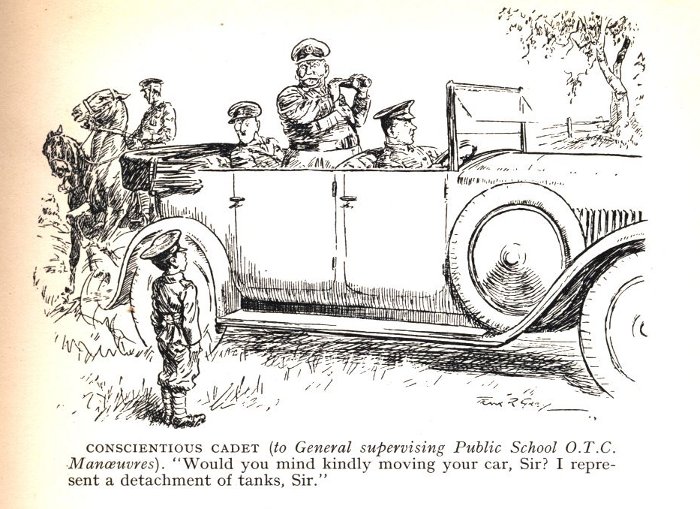
A Man at Arms; Memoirs of Two World Wars, Francis Law, 1983
In 1930 the regiment returned to London, this time to the Tower, and we took a house in Chelsea where our daughter Bridget was born. I had once been a keen, even an enthusiastic, soldier, but serious soldiering grew more and more difficult. I had commanded more men as a platoon commander on joining in 1915 than now as commander of a company. Reality vanished, make-believe was the order of the day. Flags and wooden rattles, not weapons, represented machine guns. Tanks were simulated by trucks marked with a large T or by cardboard shapes mounted on bicycles, antitank guns represented by green flags. There was little ammunition for range firing and few blank cartridges for exercises. Two men in canvas clothing carrying 'pole targets' with flapping strips of canvas represented a section, four such a platoon. Imagination was to be stretched to the limit and indeed far beyond. The pleasure of a day on horseback umpiring an exercise could not compensate for the stark unreality of the training: the whole thing was bogus.
The day of the Scrooge and the anti-hero had arrived. Everything - books, the press, the theatre - all conspired to ridicule the services and those who served in them. In addition an economy axe was wielded ruthlessly to the satisfaction if not to the plaudits of a forgetful, complacent, thoughtless people, careless of the future which was to catch up with them in less than a decade. Professionally, like many another who had served in the war, I became increasingly sad and disillusioned. It was a time of deep frustration for any one who thought realistically and was eager to give useful service. With many another I was forced to question the wisdom of remaining in the army with its prospects so bleak, with no glimmer of light ahead. Married, with the prospect of yearly changes of house a strain on finances and the inevitable restrictions on our freedom, I decided in 1931 to retire from the army and joint the regular army reserve of the Irish Guards.

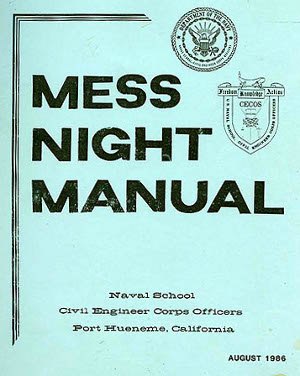 From the US Navy Department Library comes the 1986 edition of the Mess Night Manual published by the Naval School, Civil Engineer Corps Officers, Port Huenema, California, dated August 1986.
From the US Navy Department Library comes the 1986 edition of the Mess Night Manual published by the Naval School, Civil Engineer Corps Officers, Port Huenema, California, dated August 1986.
A "Mess Night" is a scheduled evening when mess members and their guests gather in the mess for dinner. A formal Mess Night is referred to as a "Dining-In." Normally only officers of the mess and command guests are included. When spouses and other personal guests are invited, the occasion is called a "Dining-Out." Throughout this publication, the term "Mess Night" will be used as synonymous with both "Dining-In" and "Dining-Out." "Dinings-In" and "Dinings-Out" are conducted in the same format. The only difference is in the attendees.
A Mess Night is more than an officer's dinner party. It is a military formation, as old and as rich in tradition as the quarterdeck or the mounting of the guard, and as essential to a close-knit, smooth-performing unit as are drills, inspections and military ceremonies. Throughout the messes of the world, military men meet to honor their regiments, ships, standards, battles and dead. It is significant to note that irrespective of nationality, these mess formations vary in form only so much as do the traditions of the military organizations. It cannot be too strongly emphasized that mess night is not a party in any sense; it is very similar to honors, for its purpose is to solemnly pay tribute to all of those intangibles for and by which the military unit stands.
The Mess Night format is derived through tradition from a number of sources, particularly the Vikings and the British Navy. Meticulous attention should be given to the traditional aspects of this format.
The "Dining-In" had its inception in the earliest military victory celebrations. In the opening centuries of the Christian Era, it took its first step toward a stylized format in the revels of the Viking Clans on the occasion of their return from successful raids and forays against distant shores. These celebrations saw all male clan members present with the exception of the watch. The leader took his place at the head of the board with all others to his right or left in descending order of rank. Those of the clan who did not participate in the raid were seated below the salt, and did not participate in the disposition of the spoils. Warriors who had conducted themselves with valor or distinction were "guests" for the evening. They were seated closer to the leader than their rank normally entitled them. These "guests" customarily received a bonus from the share of the leader for their deeds.
The celebrations of the Vikings were great feasts where vast quantities of food and drink were served. Down through the millennium since the heyday of the Norsemen, the practice of recognizing and perpetuating the anniversaries of significant battles and feats of outstanding heroes by formal ceremony became generally adopted as a natural outgrowth of the special camaraderie of the military.
Like so many of our service traditions, the term "Mess Night" and the format used in the U.S. Navy today was derived from the British Navy. Although the tradition is very old in England, it is not exclusively military. Tradition has it that the custom began in the monasteries, was adopted by the early universities, and later spread to military units when the officers' mess was established. At one time, the formal dining procedure was observed nightly in the British military messes. This nightly formality and elegance was abandoned by the United States Navy when alcoholic beverages were abolished aboard ship by General Order 99. However, Mess Nights are still observed on special occasions such as an anniversary, a commissioning or decommissioning, the visit of a senior officer, or simply to enjoy good company.

The manual is divided into several sections for the convenience of the reader.
The manual also contains several appendices which may be of assistance in planning a Mess Night.

The Damned Die Hard, Hugh McLeave, 1973
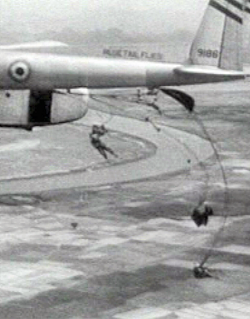 But for every man lost [at Dien Bien Phu], the French had two or three volunteers stepping forward to take his place. Lieutenant Colonel Maurice Lemeunier, with a safe Hanoi billet, heard that his friend Gaucher had died. He went to General Cogny, in charge of the Dien Bien Phu operation in Hanoi. "Mon ge'ne'ral, I'm the oldest legionnaire in Tonkin. Gaucher's place should come to me."
But for every man lost [at Dien Bien Phu], the French had two or three volunteers stepping forward to take his place. Lieutenant Colonel Maurice Lemeunier, with a safe Hanoi billet, heard that his friend Gaucher had died. He went to General Cogny, in charge of the Dien Bien Phu operation in Hanoi. "Mon ge'ne'ral, I'm the oldest legionnaire in Tonkin. Gaucher's place should come to me."
"But Lemeunier, if I said yes, how do we get you there?"
"I jump."
"Why, you don't know one end of a parachute from the other."
Nevertheless, Lemeunier jumped—and at night with only a flare to indicate the dropping zone. And Staff Captain Jean Pouget left his safe seat in General Navarre's headquarters to take his first jump. And hundreds of others, including Sergeant Chief Janos Valko, a legendary Hungarian NCO, made their first parachute jump in the dark. De Castries, now a general, Langlais, Lemeunier, and Major Vadot were playing bridge in the "Subway" (nickname for the headquarters tunnel system) when a thump shook the roof. "That one didn't go off," said Vadot, who had been in Gaucher's dugout. They heard footsteps crunch; a giant legionnaire appeared, still entangled in the chute he was wearing for the first time. Unabashed by all the gold braid, he accepted and drank half a pint of Vinogel from the general. Those first-time paratroopers revised military thinking about airborne operations. More than seven hundred dropped and had no more broken bones than the 2,300 regular paratroopers who jumped alongside them. One had a harrowing experience; after crash-landing in the dark, he groped for his bearings; his fingers encountered one icy face, then another. He had landed in the morgue. It took half a pint of brandy to bring him around.
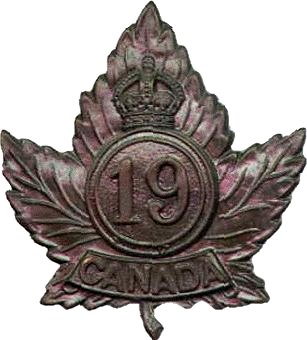
"The Orderly Sergeant," Five Nines and Whiz Bangs, 1937
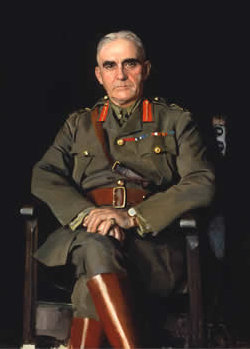
Lieutenant General Sir Sam Hughes, K.C.B., M.P.
Painted by Harrington Mann
Beaverbrook Collection of War Art
CWM 19710261-0394
The weirdest notes ever sounded on this earth were heard at the Exhibition Grounds one raw, winter's day in December, 1914. The Hon. Sam Hughes had travelled down from Ottawa to review the troops, and there we stood, shivering and grousing, knee-deep in snow, waiting for the Great Man's arrival. On this occasion he was to be accompanied by the Governor-General, H.R.H. the Duke of Connaught, who was very interested in the various gangs of enthusiasts scattered throughout Canada, all trying to learn this new soldiering game.
He did come, his descent being signalised by a snappy bit of invective levelled at General Lessard for something or other. Things got mixed. Everybody was in a rotten temper. The 19th Battalion tried to present arms from the order, or it may have been the other way about; and the pipe-band of the 19th made a stab at playing "God Save the King."
Did you ever hear a pipe-band playing the National Anthem? Did you? Well, did you ever hear a pipe-band, whose instruments were all frozen solid, trying to do it?
The squeaks and groans, the wails and the mi-a-a-oos that shuddered and shrilled from these bagpipes were plain awful. Some of the lads tried to go right through with it. Others, caught a few bars behind when the pistol went off, hurried along to catch up. One or two kept tuning up—all at the same time.
You'll understand, then, what I mean when I said the weirdest noises ever distilled on this earth poured into our ears that dreadful day. Dear old Sam got apoplectic. He stamped around roaring and hollering — "Take that g—d—band outa here," he bellowed.
Frightened brass hats, glad to escape from the wrath, scurried over to convey Sam's profound displeasure to the aggrieved virtuosi.
Discouraged, but unconquered, the pipers vanished.

Lessons Not Learned: some of the First World War era tanks that Canada bartered for on
the outbreak of the Second World War as much needed trainers to fill the capability gap
left by having none in Canadian inventories.
The Montreal Gazette, 26 November 1949
(Gazette Resident Correspondent)
Ottawa, Nov. 25.—Evidence of a startling shortage of ultra-modern equipment in the Canadian Army was indicated when the House of Commons studied Defence Department estimates yesterday.
Defence Minister Claxton admitted that "no provision whatever" was being made for new types sof tanks and self-propelled guns for armored regiments.
He disclosed that the recoilless rifle — and extremely efficient weapon developed at the end of the war — was a complete stranger to the Canadian Army.
He revealed that the proximity fuse — which appeared about the time of the Battle of the Bulge in 1944 and began to revolutionize artillery warfare — was not to be found in a single shell in Canada.
Questioned by incredulous officers sitting on the Opposition benches, Mr. Claxton shrugged his shoulders when questioned about the lack of all of these items and asked, in return, where could you buy them?
It started when Lt.-Col. D.S. Harkness (PC, Calgary East) asked about armor.
"Has there been any provision for new types of tanks and self-propelled guns in the past year or during the remainder of the year covered by these estimates?" he asked.
"No." Mr. Claxton told him. "There is no provision whatever." Col Harkness suggested that there should be some provision.
"Then I would ask the honorable member if he can tell me where he can get the tanks." commented the Defence Minister.
The Calgary M.P. Suggested that there should be an excellent possibility of picking up self-propelled guns of the recoilless model.
"We should be glad to hear about it," said the minister.
Opposition Leader Drew unearthed the proximity fuse lack.
Would the minister say, he asked, how many artillery or mortar shells in Canada were equipped with proximity fuses, one of the deadliest of modern warfare devices?
He sat down and waited expectantly, as Mr. Claxton rose.
"Not a one," declared the minister and sat down again.
The leader of the Opposition charged that this disclosure was proof that the artillery branch of the Canadian Army was not adequately equipped for modern defence emergencies and it was probably true, too, of other branches, he suggested.
The Defence Minister cut in to ask Mr. Drew what nations the latter believed were equipping their forces with proximity fuses. Mr. Drew named the United States, the United Kingdom "and the nation about which we are most concerned"—Russia.
![]() Follow The Regimental Rogue on facebook.
Follow The Regimental Rogue on facebook.
| « | May 2014 | » | ||||
| S | M | T | W | T | F | S |
| 1 | 2 | 3 | ||||
| 4 | 5 | 6 | 7 | 8 | 9 | 10 |
| 11 | 12 | 13 | 14 | 15 | 16 | 17 |
| 18 | 19 | 20 | 21 | 22 | 23 | 24 |
| 25 | 26 | 27 | 28 | 29 | 30 | 31 |